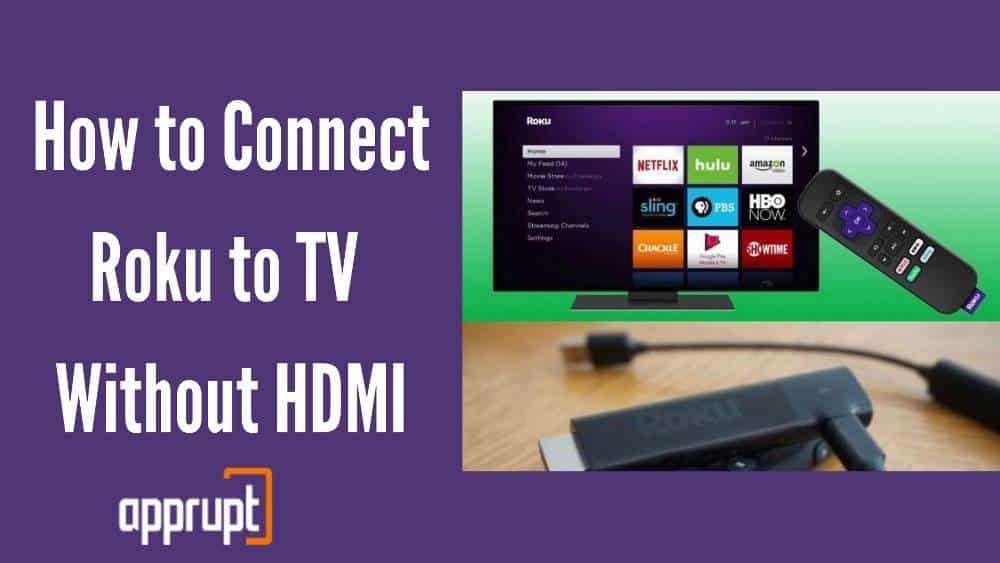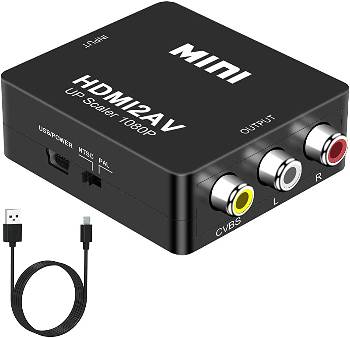This article will show you how to Connect Roku to TV Without HDMI or your non-smart TV. These instructions will work on any Roku device.
With Roku, you can stream your favorite shows around the world. Although, setting up your Roku device is easy if your TV has an HDMI port. But, if you have a TV that lacks an HDMI port or is a non-smart TV, you may face difficulties in streaming the shows or movies. However, you don’t have to worry, there are other ways around this problem.

3 ways to Connect Roku to TV Without HDMI Port
There are three major ways to connect a Roku player to a TV without having an HDMI port:
- utilizing a Converter Box,
- composite cables, or
- using an HDMI to AV converter.
Although using the converter box is the easiest way to go.
With these easy-to-follow methods, you’ll be able to view your favorite streaming services on your non-HDMI TV.
1. Using a Converter Box
Your TV will most likely recognize an analog signal if you don’t have an HDMI connection.
You’ll need an HDMI to RCA converter box to connect your Roku device to a non-HDMI TV. A converter box converts an HDMI connection to an analog connection that your non-HDMI TV can recognize, allowing you to connect your TV to a Roku device.
Follow the steps mentioned below to use a converter box to connect your Roku device to your TV without HDMI ports:
Step 1: Insert the Roku stick into the converter box’s input and connect it to a power supply.
Step 2: Connect the converter’s three RCA/composite cable outputs to the relevant ports on your TV (yellow, white, and red ports).
Step 3: Simply use the provided AC converter to plug the USB cable (or the DC power adaptor for the Ultra) into an output, or any powered USB port if that isn’t available.
Step 4: Connect the USB port to a power supply. Turn on your television and choose “Composite” or “TV/AV” as the input.
Step 5: Follow further instructions on the TV and enjoy the content!
2. Using Composite Cables
Roku is available in a variety of variants, some of which are compatible with composite video connections. If your TV doesn’t have HDMI or composite inputs, it most certainly has a component input.
Component ports resemble composite ports in appearance. They are colored green, blue, red, and white, and there are five of them instead of three.
You can buy a composite to HDMI converter if your Roku device doesn’t support composite video cords.
To connect your Roku device to your older TV, simply follow the procedures mentioned above, but instead of using an HDMI connection, use composite video cords to connect the devices.
3. Use an HDMI to AV Converter
A video converter, USB cable, and power cable are commonly included with an HDMI to AV converter. You can use any of the mentioned cords to connect to your device.
Step 1: Connect the Roku device’s HDMI cords to the adapter.
Step 2: Connect the AV/RCA cables to the TV’s AV port (yellow, red, and white wires). And attach the adapter’s power cord.
Step 3: Connect the Roku device to the TV using the same connections. After that, connect them to a power source and turn it on.
Step 4: The Roku signal will appear on the TV screen after your device is turned on. Select the source on the TV screen with the Roku remote. Choose a TV or AV source.
Step 5: Follow further instructions on the TV and enjoy the content!
Roku for Old TV without HDMI
There’s no need to be concerned if you don’t have an HDMI television at home. Your old TV can still be used to connect to a Roku device.
You’ll need an HDMI converter and/or an RCA cable to connect a Roku device to a non-HDMI TV.
On the other hand, If you don’t want to go through the tedious process you can go for Roku Express+, it was created particularly to use composite inputs rather than HDMI.
Can Roku connect to the TV wirelessly?
Yes, a wireless connection to a router is available on all Roku streaming devices. Some of the Roku streaming devices feature an Ethernet connection or connect to the internet through a third-party adapter.
Select the ‘Wireless’ option during the first setup. The Roku device will look for Wi-Fi networks to connect to. Choose yours, type in the password, and click Connect.
To make a later connection: Home > Settings > Network > Set Up Connection > Wireless. Select a network, type in the password, then click Connect.
By this method, one could easily utilize the Roku streaming service wirelessly.
Also Read: Can You Use Roku on a Non Smart Tv
Can you Use Roku without HDMI?
Except for Roku Express+, all other Roku requires an HDMI port to connect to your TV. A Roku player requires an HDMI cable to connect, however, the Roku Streaming Stick connects immediately with its built-in HDMI connector.
Although, most TVs have either HDMI or RCA inputs. If your TV doesn’t have an HDMI port, it will have RCA connectors instead. The iconic red, white, and yellow wires, or red, blue, and green ports, are RCA ports.
So although an HDMI port may help connect to the Roku streaming platform, it’s not necessary to have one, as there are a plethora of methods to connect to Roku without it.
Conclusion
Are you excited to use a Roku device to stream video to your TV? You’ll be relieved to learn that this convenience isn’t restricted to HDMI TV owners.
Users with non-HDMI televisions can utilize an HDMI to RCA converter to connect to a Roku device. You may pick between converter boxes with or without built-in HDMI and/or RCA cables, which are widely accessible online. The majority of these HDMI adapters can handle 1080p video.
You can also acquire a Roku Express+ device, which works with both HDMI and composite TVs. A composite cable is included in the package, which may be immediately linked to the Roku stick.
Which approach are you going to try? Do let us know!

